You have been working on the canter with your horse and you know it is not the best but it also doesn’t feel like the worst.
You sense your horse may be unbalanced in the canter, the canter departs and or in the downward transitions but you can’t quite put your finger on it.
There are a handful of signs you can look out for that will tell you if your horse is unbalanced in the canter.
Though it is not always the case, horses can be unbalanced due to discomfort or pain, so always rule out the pain factor if your horse is having balancing issues.
Okay now for 10 signs your horse is unbalanced with the canter.
Table of Contents
Sign 1- Speeding Up In The Trot When Transitioning To The Canter
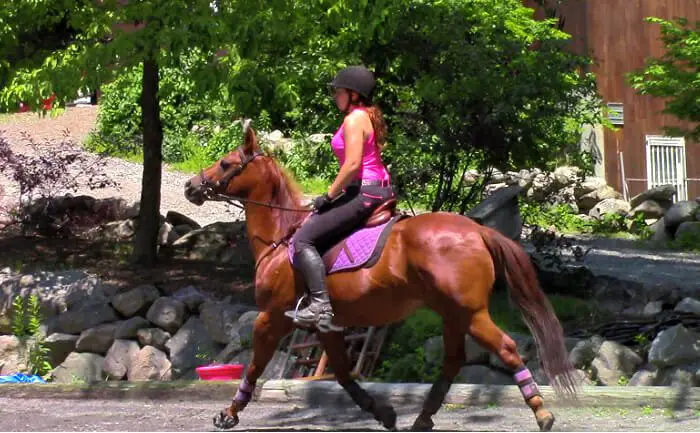
You set your horse up for a canter transition. The trot seems fairly balanced and energetic. You are riding into the corner of the area where you plan to ask for the canter.
As you ride into the corner you ask for the canter.
But instead of your horse nicely picking up the canter, your horse’s bum drops into second gear and races into an unbalanced fast trot.
You feel discombobulated and all over the place.
Your horse’s nose is up in the air looking like a camel, as you try to half halt and bring your horse, back to a sensible trot. Or even down to a walk so you can both regain your composure.
Horses that run into the canter are unbalanced. They are typically on the forehand which makes it harder to pick up the canter.
Sign 2- Bulging Shoulder & Moving Crookedly
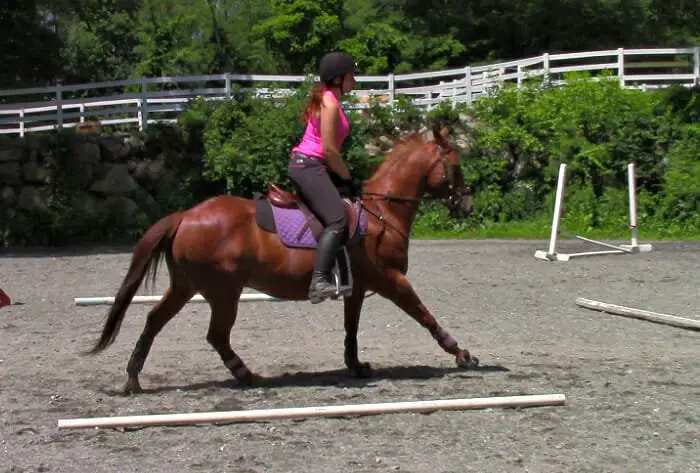
You pick up the canter and before you know it your horses head is turned to the outside, inside shoulder bulging to the inside and the hind quarters are also to the inside.
You wonder whether or not your horse is trying to leg yield or maybe do haunches in.
You contemplate whether you should just pretend you are working on leg yield at the canter because people are watching.
But you know deep down your horse is just traveling extremely crooked.
Horses that bulge their shoulders and move crookedly are unbalanced. They are compensating for their lack of balance by traveling crookedly.
Sign 3- Falling In Or Turning During The Canter Transition
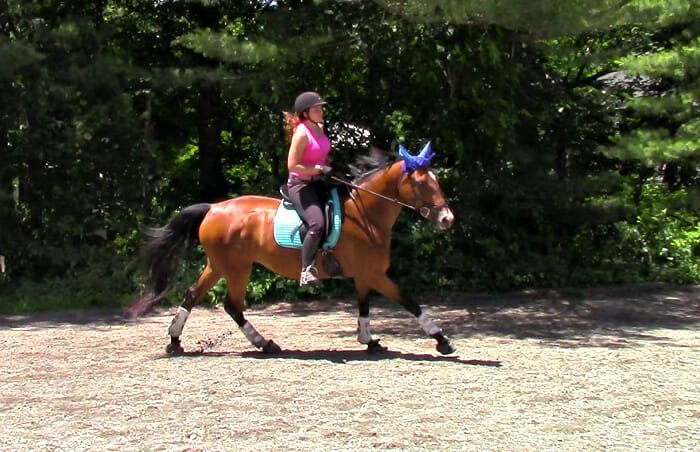
Your horse is trotting well and you sit the trot as you prepare for your canter transition. You give a quick half halt before you ask for the canter.
As soon as you apply the aids for the canter your horse swiftly turns to the inside of the area.
Slightly off balance you fix yourself in the saddle and bring your horse back out to the track.
He was going so well at the trot and now he is wiggly and keeps wanting to turn in and cut off the corners whenever you ask for the canter.
Your horse is unbalanced and putting too much weight on the inside legs.
You could also be accidentally cueing your horse to turn.
Or your horse is confused and thinks you want them to turn.
Or your horse is trying to get out of doing work by trying to go to the center of the arena for you to get off.
Sign 4- Picking Up The Wrong Lead

You have set your horse to pick up the canter in the corner of the arena. You have him bending to the inside, he is moving nice.
You expect a good transition into the canter.
Your horse responds to your aids transitions right into the canter. But oh no not again.
It is the wrong lead.
Going to the left, you have no problem getting the left lead canter. But going to the right is so difficult it is always a 50/50 chance to get the right canter lead.
Your horse has balancing issues. Your horse may be more balanced in one direction than the other, usually because the horse has a stronger side.
Related Article: How To Effectively Ask Your Horse To Canter
Sign 5 Cross Firing With The Hind Legs
You get your horse trotting on a circle. They are forward, in a good rhythm, and seem responsive to your leg.
You ask for the canter on the circle. Your horse does what seems a little hop into a very awkward feeling canter.
The front end feels like it is moving one way while the hind end is moving the other way. You compare the movement to being tossed around in a dryer.
You feel all over the place with this disunited canter so bring your horse, back to a trot.
Your horse is unbalanced and trying to compensate for the lack of balance and most likely hind-end weakness by cross-firing also known as cross cantering.
Cross firing also has other potential causes you should look into, for example, ill-fitting equipment, back pain, hind leg pain.
Sign 6- Leaning on your hands in the canter and speeding up.
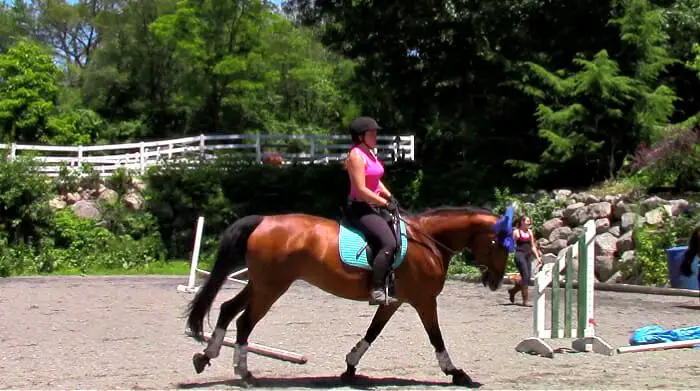
You pick up your canter and not but a few second later your horse is lowering their head and leaning on the bit.
You feel the weight come into your hands and try to sit up tall as you feel yourself getting pulled forward.
You apply some half halts which give momentary lightness before feeling the weight come into your hands.
As you go down the long side of the arena, you feel the canter get faster and faster.
Your horse is on the forehand, unbalanced, and relying on your hands for support.
There are circumstances where horses have been handled roughly with the reins and bits and they learned to lean into the pain. Like a baby teething that bites their gums into whatever they can get their hands on.
A horse like that may need retraining to accept the bit.
Sign 7-Falling In Or Leaning In On Turns Or A Circle
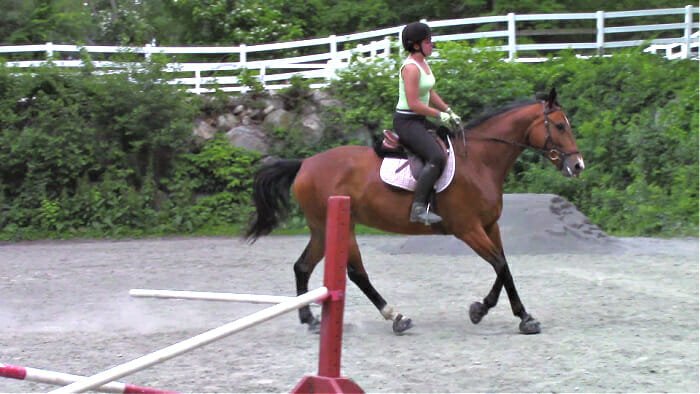
You pick up your canter in the second corner and happily go along down the long side of the arena, cantering with a slight smile on your face.
This is great you think. Your keeping a steady rhythm. Your horse is straight. Then you come to the corner at the end of the long side.
Instead of bearing weight on the outside limbs and bending around the corner. Your horse keeps their body straight and leans in like a motorcycle on a turn.
Holy moly, that was a little scary you think. As you realize you also just cut off the whole short side of the arena.
Your horse is not balanced around the turn. They are also rigid and not supple. Your horse may have tightness in their body they need to work out, as well as muscle weakness.
Your horse needs to work on going into the corner, bending, putting weight on the outside limbs, and moving off of your inside leg.
Sign 8- Breaking Into The Trot Instead Of Maintaining The Canter
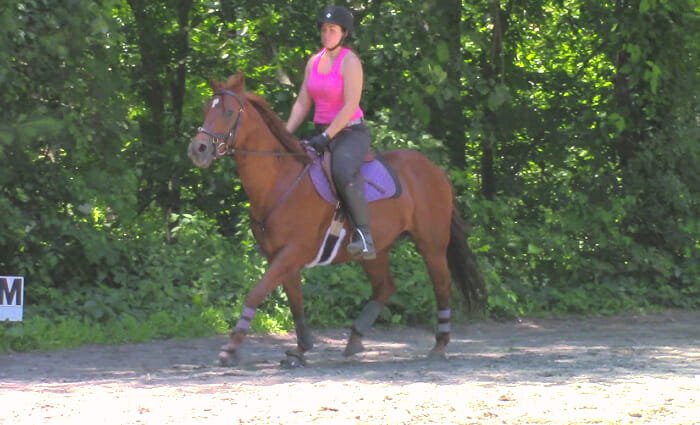
Your horse seems a little lazy today. So you work on getting her more responsive with walk- trot and halt- trot transitions.
Finally she seems more forward and ready to do some canter work. In fact she is very responsive to the legs now. You have been trying to get her back in shape after some time off.
When your ready you pick up the canter on a 20 meter circle. Your cantering along ready to complete your first circle and suddenly she breaks into a racing trot.
You gather her back up to a more balanced slower trot and pick up the canter again. This time she breaks into the trot only half way around the circle.
Your horse is unbalanced in the canter and breaks into the trot when they feel their balance is off. It can also be due to a lack of fitness and strength.
Sign 9- Bucking In The Canter Or In The Canter Transition

You trot a circle a few times to prepare for the canter. Your hands are up and you know what might be coming.
You try to stay calm and cool, but you feel a slight knot in your chest when you ask for the canter.
As soon as you round to the corner and apply the canter aids your horse pins their airs, picks up the canter and let’s out a solid buck.
Luckily you stay on and try to adjust yourself in the saddle. Your horse is careening around a bit and you half halt to gather them back.
Another buck lets loose, and you come out of the saddle a little, losing a stirrup. You get your stirrup back and continue around the circle in the canter. After a circle at the canter with no bucking you come down to the trot and then a walk.
In this situation, it can commonly be pain or discomfort from poor saddle fit.
The horse can also be feeling fresh with extra energy, especially with youngsters.
But bucking can also be the horse’s reaction to feeling unbalanced in the canter.
Sign 10- Falling Into A Racing Trot In The Downward Transition
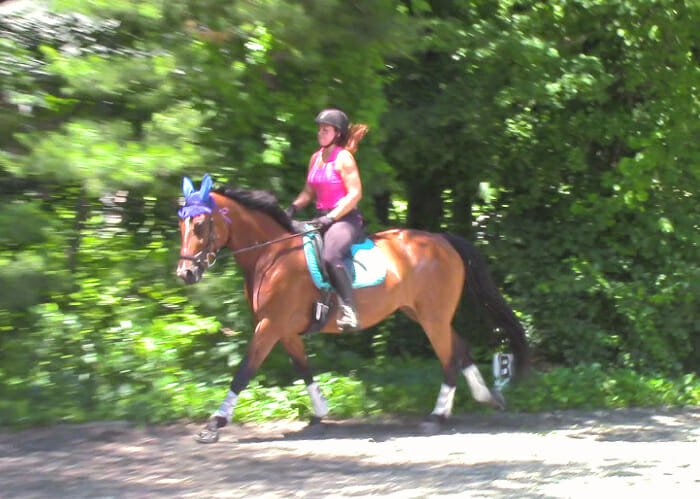
You are happy with how your horse is going today. He had a nice trot, relaxed and balanced. The canter transition was nice.
You canter along and it feels like you are riding a rocking horse. You canter a circle and a full lap around the arena.
Then you decide to come back to the trot.
You ask your horse to come back from the canter and suddenly your horse drops into the canter careening around at the trot, like a standardbred trotting at the races.
You bounce around trying to bring your horse back and organize their trot. You know you are looking like a hot mess.
What just happened.
Your horse was balanced before hand and doing well at the canter. But the downward transition from the canter is unbalanced.
The horse comes onto the forehand in the downward transition becoming unbalanced.
They may also keep going faster with cantering still on the mind. They are anticipating the canter and getting hotter to the leg aids.
What cantering struggles do you have with your horse?
Stay tuned for more blog posts on the canter.
Cheers, Kacey

